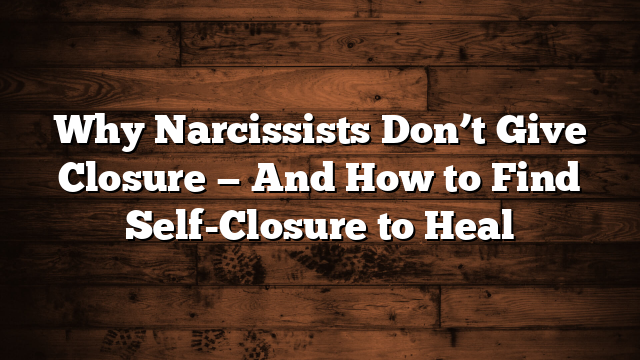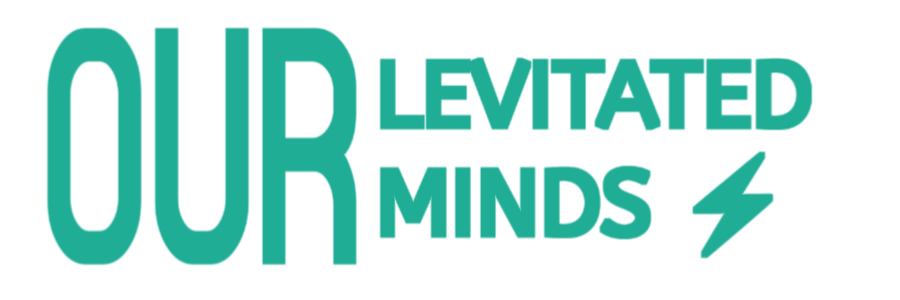Why Narcissists Don’t Give Closure — And How to Find Self-Closure to Heal
Narcissists Don’t Want Closure — They Want Control
If you’ve ever been involved with a narcissist, you might have experienced the frustrating cycle of ghosting, hurtful behaviour, blame, and then a sudden reappearance with a request for “closure.” It feels confusing, painful, and never quite resolves anything. But here’s the truth many don’t realise: narcissists don’t want closure — they want control.
Behind The Mask: The Rise Of A Narcissist
Why Closure from a Narcissist Isn’t Real Closure
Closure, by definition, is meant to bring peace and finality. It’s supposed to give you a sense that the chapter is closed, so you can heal and move on. But with narcissists, closure as you understand it simply doesn’t exist.
When a narcissist disappears and then suddenly resurfaces asking for “closure,” it’s not about bringing peace. It’s not about saying goodbye properly or making amends. Instead, it’s about checking if the door is still open — if you’re still emotionally vulnerable, still unsure, still available to them.
What might feel like a final conversation or the end of the story to you is just a new round in their game of manipulation. They don’t want to close the book — they want to keep it open, with bookmarks ready for their next move.
“Closure” as a Control Tactic
Narcissists often claim they want to talk “just to get closure.” But in reality, that’s rarely true. What they’re after is control.
When they say, “I just want to talk,” what they really want to know is:
- Are you still hurt?
- Are you still confused?
- Are you still emotionally available?
- Are you still open to their influence?
If the answer is yes, they know they still hold power over you. They don’t want understanding or reconciliation — they want to know their control still works.
This need for control is at the heart of narcissistic behaviour. It’s about maintaining dominance, keeping you off-balance, and making sure you stay stuck in the trauma bond they created.
The Trauma Bond Reset
What many people call “closure” with a narcissist is actually a soft reset of the trauma bond.
A trauma bond is an intense emotional attachment that forms through cycles of abuse, manipulation, and intermittent kindness. It’s one of the reasons narcissistic relationships feel so addictive and so hard to leave.
When a narcissist resurfaces asking for closure, they often stir up old emotions, spark confusion, and remind you of the “good times.” Suddenly, you question your progress and wonder if you misread everything.
This isn’t healing. It’s hooking you back in — resetting the trauma bond so they can continue to control you.
The narcissist is fully aware of this cycle and uses it intentionally. They don’t want you to feel closure because closure means you’re free from them.
Why It Never Feels Finished
The reason that “final conversation” or “closure talk” never gives you peace is because it’s never truly final — at least not to the narcissist.
They’ll often:
- Leave things unsaid,
- Twist your words,
- Bait you into reacting,
- Or shift blame back onto you.
These tactics create confusion, frustration, and emotional turmoil. They keep you caught in a loop of trying to explain yourself, defend your feelings, or prove your perspective.
The narcissist thrives in this loop because it means they still have power. The only way to break free is to step out of the loop completely.
Self-Closure: The Real Closure
Here’s the hard but freeing truth: You don’t need a narcissist’s apology or explanation to move on.
You don’t need their validation, their version of the story, or their understanding. What you need is self-closure.
Self-closure means deciding for yourself that you’ve had enough. It means choosing peace over chaos, clarity over confusion, and healing over being stuck.
It’s about writing your own ending to the story, even if the narcissist keeps rereading the chapter or trying to rewrite it.
This is the only kind of closure that can truly free you. It comes from within, not from the narcissist.
How to Start Giving Yourself Self-Closure
- Accept the reality: Understand that the narcissist is unlikely to give you the closure you want because they don’t want to lose control.
- Set firm boundaries: Limit or cut contact if possible. Block or mute if you need to. Protect your emotional space.
- Validate your feelings: Your emotions are real and valid. You don’t have to justify your hurt or confusion.
- Write your own narrative: Journal your feelings, write letters you don’t send, or speak affirmations to yourself that acknowledge your growth.
- Focus on your healing: Engage in self-care, therapy, or supportive communities where your experience is believed and supported.
- Let go of needing answers: Sometimes, the questions will remain unanswered, and that’s okay. Your peace doesn’t depend on their explanations.
Closing Thoughts
Narcissists don’t give closure — they give confusion. They keep you guessing, doubting, and emotionally trapped because that’s where their power lies.
The real power to heal and move on comes from choosing your own peace. Give yourself the closure they never will. Decide that the chapter is over, even if the narcissist keeps flipping through the pages.
You deserve freedom. You deserve clarity. You deserve peace.
If you’re choosing peace over chaos, remember to take care of yourself and surround yourself with people who respect and value you.
Check these out!
Behind The Mask: The Rise Of A Narcissist
15 Rules To Deal With Narcissistic People.: How To Stay Sane And Break The Chain.
A Narcissists Handbook: The ultimate guide to understanding and overcoming narcissistic and emotional abuse.
Boundaries with Narcissists: Safeguarding Emotional, Psychological, and Physical Independence.
Healing from Narcissistic Abuse: A Guided Journal for Recovery and Empowerment: Reclaim Your Identity, Build Self-Esteem, and Embrace a Brighter Future
(Sponsored.). https://betterhelp.com/elizabethshaw
Advertisements
Click on the links below to join Elizabeth Shaw – Life Coach, on social media for more information on Overcoming Narcissistic Abuse.
On Facebook.
On YouTube.
On Twitter.
On Instagram.
On Pinterest.
On LinkedIn.
On TikTok
The online courses are available by Elizabeth Shaw.
For the full course.
Click here to sign up for the full, Break Free From Narcissistic Abuse, with a link in the course to a free, hidden online support group with fellow survivors.
For the free course.
Click here to sign up for the free online starter course.
To help with overcoming the trauma bond and anxiety course.
Click here for the online course to help you break the trauma bond, and those anxiety triggers.
All about the narcissist Online course.
Click here to learn more about the narcissist personality disorder.
The narcissists counter-parenting.
Click here for more information on recovery from narcissistic abuse, and information on co-parenting with a narcissist.
Elizabeth Shaw is not a Doctor or a therapist. She is a mother of five, a blogger, a survivor of narcissistic abuse, and a life coach, She always recommends you get the support you feel comfortable and happy with. Finding the right support for you. Elizabeth has partnered with BetterHelp (Sponsored.) where you will be matched with a licensed councillor, who specialises in recovery from this kind of abuse.
Click here for Elizabeth Shaw’s Recommended reading list for more information on recovery from narcissistic abuse.




